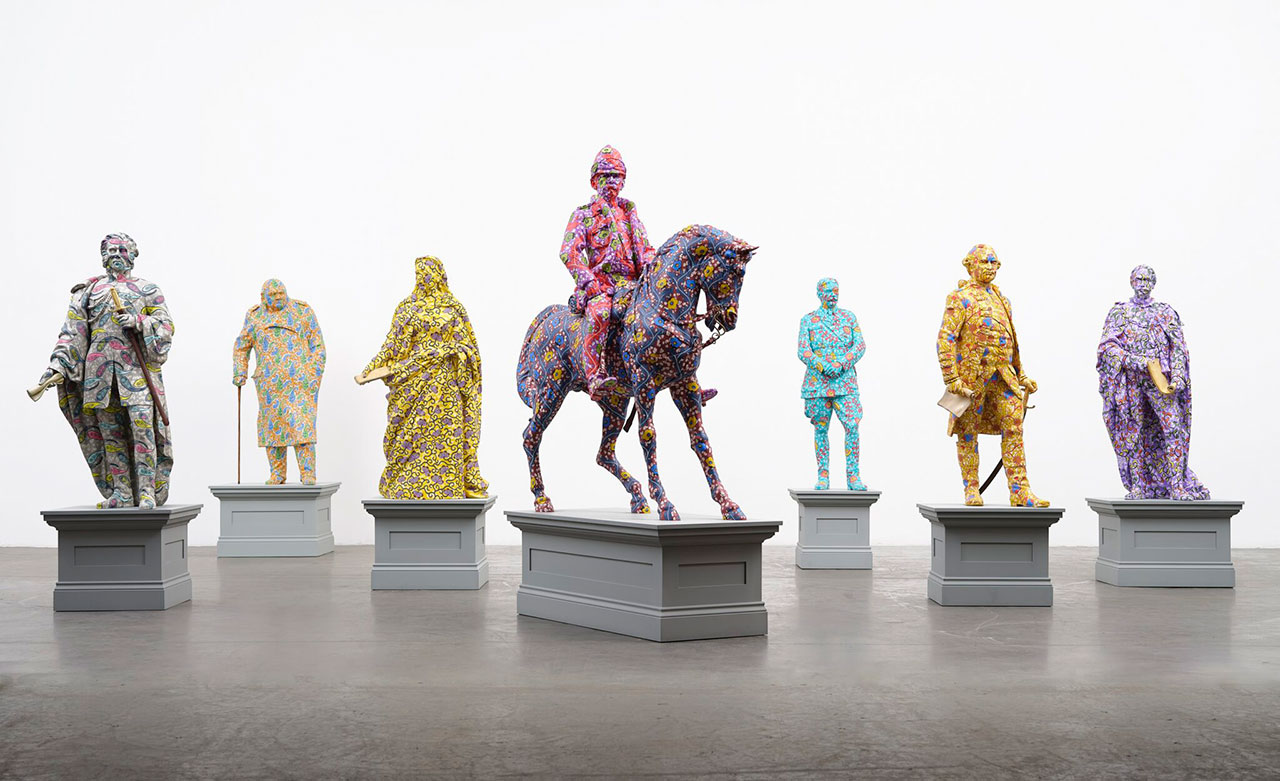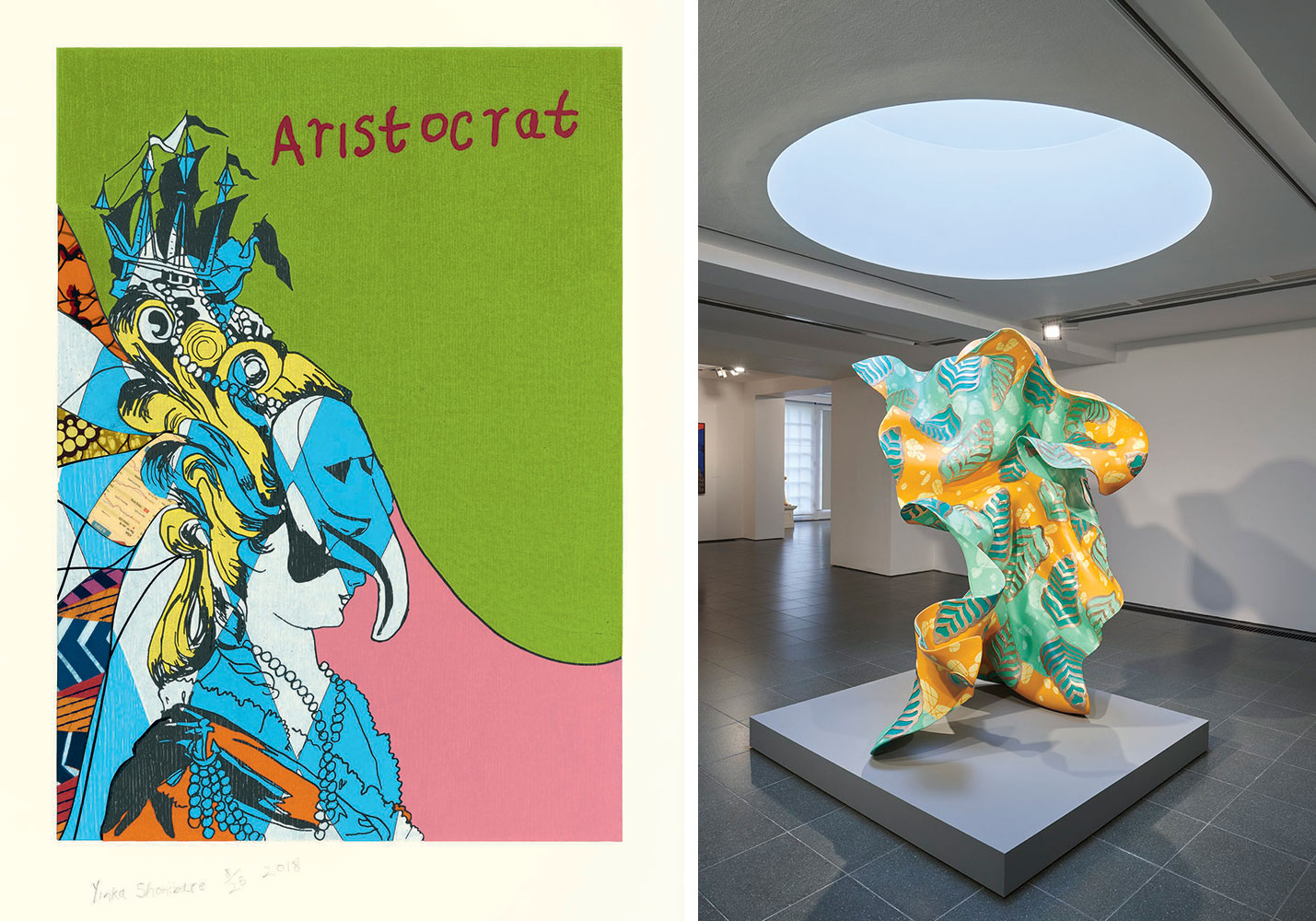TRIBUTE: Yinka Shonibare CBE-Suspended States
 Yinka Shonibare CBE explores constructions of cultural identity in a globalised world. Born in London in 1962 and raised between London and Lagos, Shonibare identifies as a ‘postcolonial hybrid.’ His work draws on theatrical, ironic and tragicomic strategies to shed light on the performance of power. As one of Britain’s most celebrated contemporary artists, Shonibare received a Commander of the British Empire (CBE) honour in 2019. The artist includes CBE as part of his professional name as a gesture towards his complex relationship to British honours and the systems they represent.
Yinka Shonibare CBE explores constructions of cultural identity in a globalised world. Born in London in 1962 and raised between London and Lagos, Shonibare identifies as a ‘postcolonial hybrid.’ His work draws on theatrical, ironic and tragicomic strategies to shed light on the performance of power. As one of Britain’s most celebrated contemporary artists, Shonibare received a Commander of the British Empire (CBE) honour in 2019. The artist includes CBE as part of his professional name as a gesture towards his complex relationship to British honours and the systems they represent.
By Dimitris Lempesis
Photo: Serpentine Galleries Archive
The exhibition “Suspended States” includes installations of recent sculptures, textiles and woodcuts, reflecting Yinka Shonibare’s recent meditations on the suspension of boundaries ‘whether psychological, physical or geographical’. Resonating with Serpentine’s location within a Royal Park, the artist’s new works explore the role of public colonial statues, sites of refuge, the legacy of war and consequential attempts at peace. His distinctive use of ‘African print’, originally Dutch wax print inspired by Indonesian batik and later traded to West Africa in the 19th century, serves as a symbol for the intricate ties between Europe and Africa. The exhibition also reveals the importance of cultural and social exchange projects to Shonibare’s practice, through his support of other artists in his Guest Projects programme held in his studio in East London since 2008, and his Guest Artist Space (G.A.S.) Foundation which was founded in Nigeria in 2019. The series of scaled-down public monuments titled “Decolonised Structures” are public sculptures in London which were originally commissioned to commemorate a colonial figure. The originals are mostly large-scale bronze sculptures placed on tall plinths. Shonibare reflects on the dynamic of scale, ‘the relationship of your body to their body is immediately a subservient one.’ Here, the sculptures are reduced in size and deliberately brought to eye level ‘to metaphorically reduce [their] grandeur… [and] power over citizens.’ The Dutch wax patterns that cover the monuments are designed by Shonibare and hand-painted onto the surface of each sculpture, some also include gold leaf. ‘I’m making them more beautiful,’ the artist explains, ‘I’m changing their character, or the history of their character, into something much more interesting.’ Rather than making a moral judgment, Shonibare invites discussion on the role of public sculptures today. Created in response to the debates around public sculptures of colonial figures, Shonibare reflects ‘I don’t think statues should be destroyed, the public should be able to see them, but there should be museums built for them so people can understand the history of these people and what they did”. “Sanctuary City” series is comprised of scaled-down replicas of historic and contemporary buildings from across the globe that have been or are considered places of refuge for persecuted and vulnerable groups. The installation highlights the basic human need for safety and shelter in a time of increasing regional conflict and socio-economic disparities. Shonibare describes shelter as ‘one of the most pressing political concerns right now.’The artist selected buildings based on their social role and importance, including temples in ancient Greece and Rome which offered protection to fugitives and slaves, religious buildings in medieval Europe which provided asylum for criminals or individuals who challenged the norms of society and intergovernmental and non-profit organisations and charities. “The War Library” examines the history of war and peace through an installation of 5,270 books bound in Dutch wax print cotton. Along the spines of 2,700 books is gold lettering naming conflicts and peace treaties which are directly or indirectly the result of imperial ambitions. Some of the books are left without lettering, indicating events that are yet to take place. “The War Library” does not aim to provide a comprehensive list of every conflict and peace process, instead it provides an insight into the global and historic reach of colonisation and the role it has in shaping society today. Some of the names of the conflicts and treaties appear on two books with alternative names or in different languages. This is to reflect how conflict and peace are often viewed subjectively and to ensure differing views are represented. Accompanying the library is an online resource providing further information and access to the extensive research conducted by a team of 10 specialists which informed “The War Library”. “Wind Sculpture in Bronze IV” captures a giant billowing cloth, hand-painted in turquoise, yellow and orange Dutch wax pattern. Unlike traditional sculpture where heavy materials are used to convey the importance of a subject, Shonibare’s Wind Sculpture in Bronze IV aims to capture lightness in bronze which he describes it as ‘making the invisible visible.’ This juxtaposition intrigues the artist, who explains “It’s almost like trying to defy gravity in a way, and I like that about the work. You’ll find that my works always have a paradox in them, which I enjoy”. Shonibare’s interest in abstraction dates back to his early piece, “Double Dutch”, exhibited at Serpentine in 1992. The work featured small canvases of stretched Dutch wax printed cotton and allowed viewers to contemplate the Indonesian-inspired ‘African print’ exported to West Africa by Dutch manufacturers. However, the main subject in this sculpture is not the fabric, but the wind. The idea came from Shonibare’s large-scale public sculpture “Nelson’s Ship in a Bottle”. Commissioned for the Fourth Plinth in Trafalgar Square in 2010, the sculpture was a 1:30 recreation of Horatio Nelson’s 1805 flagship HMS Victory with sails made from Dutch wax print. The “African Bird Magic” series features endangered birds such as the Sokoke Scops Owl, Mauritius Fody and Comoro Blue Vanga. African masks hover over the birds, symbolising ancestors who were once custodians of the birds’ habitats before colonialism and industrialisation endangered many species. The quilt series also highlights the historical journey of African masks to the West, often tied to colonial exploitation and trade, which influenced modernist artists like Henri Matisse, Pablo Picasso and Amadeo Modigliani. The Hereford Cathedral’s “Mappa Mundi”, the largest surviving medieval map, charts the geography, history and destiny of humanity as it was understood in late thirteenth and early fourteenth century Christian Europe. Sometimes described as a ‘T and O map’, it depicts the Mediterranean as a ‘T’ shape dividing Asia, Europe and Africa which fills the shape of an ‘O’. Jerusalem is at the centre both pictorially and as a reflection of its importance as a Christian holy land. Informed by descriptions from early travellers and myths, the outlying areas were inhabited by chimeric beings and mythical beasts. The “Creatures of Mappa Mundi” series of quilts responds to the Hereford Cathedral’s “Mappa Mundi”. Recreated in Shonibare’s quilts are the mythical creatures of the Mandragora, a plant located in Africa that is sometimes described as a little bearded man, whose screams are said to be deadly; and in Asia dwelt the Bonnacon, a bull-like creature known for defending itself with caustic excrement. The artist reveals how the historical portrayals of these creatures in foreign places reflect fear of the unfamiliar or alien that can lead to xenophobia. The “Cowboy Angels” woodcut series depicts cowboy tropes from the American West with the text ‘Angel’ hovering above. Each cowboy is depicted with angel wings and an African mask superimposed over their face. Shonibare reflects how ‘the Cowboy Angel is an embodiment of good and evil, it is opposed to binary positions of good and evil.’ In these works, he also experiments with the woodcut print medium. Shonibare creates cuts in the printed paper to reveal Dutch wax print and collages with Financial Times paper as a commentary on economic dynamics connecting countries and ‘to signify power relations.’
Photo: Yinka Shonibare CBE, The War Library, 2024. Courtesy Yinka Shonibare CBE and Goodman Gallery, Cape Town, Johannesburg, London and New York; James Cohan Gallery, New York; and Stephen Friedman Gallery, London and New York. Photo: © Stephen White & Co.
Info: Curators: Tamsin Hong and Alexa Chow, Serpentine Galleries, Serpentine South Kensington Gardens, London, United Kingdom, Duration: 11/4-1/9/2024, Days & Hours: Tue-Sun 10:00-18:00, www.serpentinegalleries.org/


Right: Yinka Shonibare CBE: Suspended States, 2024. Installation view, Serpentine South. © Yinka Shonibare CBE 2024. Photo: © Jo Underhill. Courtesy Yinka Shonibare CBE and Serpentine

![Left: Yinka Shonibare CBE, African Bird Magic (Mauritius Fody & Comoro Blue Vanga), 2023. Commissioned by Meadow Arts. Courtesy Yinka Shonibare CBE and Goodman Gallery, Cape Town, Johannesburg, London and New York; James Cohan Gallery, New York; and Stephen Friedman Gallery, London and New York. Photo: © Stephen White & Co.Right: Yinka Shonibare CBE, Decolonised Structures (Frere), 2022 [detail]. Commissioned by Sharjah Art Foundation. Courtesy Yinka Shonibare CBE and Goodman Gallery, Cape Town, Johannesburg, London and New York; James Cohan Gallery, New York; and Stephen Friedman Gallery, London and New York. Photo: © Stephen White & Co.](http://www.dreamideamachine.com/web/wp-content/uploads/2024/04/06a-1.jpg)
Right: Yinka Shonibare CBE, Decolonised Structures (Frere), 2022 [detail]. Commissioned by Sharjah Art Foundation. Courtesy Yinka Shonibare CBE and Goodman Gallery, Cape Town, Johannesburg, London and New York; James Cohan Gallery, New York; and Stephen Friedman Gallery, London and New York. Photo: © Stephen White & Co.

![Left: Yinka Shonibare CBE, Decolonised Structures (Clive), 2022 [detail]. Commissioned by Sharjah Art Foundation. Courtesy Yinka Shonibare CBE and Goodman Gallery, Cape Town, Johannesburg, London and New York; James Cohan Gallery, New York; and Stephen Friedman Gallery, London and New York. Photo: © Stephen White & Co.Right: Yinka Shonibare CBE, Creatures of the Mappa Mundi, Bonnacon, 2018. Commissioned by Meadow Arts. Courtesy Yinka Shonibare CBE and Goodman Gallery, Cape Town, Johannesburg, London and New York; James Cohan Gallery, New York; and Stephen Friedman Gallery, London and New York. Photo: © Stephen White & Co.](http://www.dreamideamachine.com/web/wp-content/uploads/2024/04/07a-1.jpg)
Right: Yinka Shonibare CBE, Creatures of the Mappa Mundi, Bonnacon, 2018. Commissioned by Meadow Arts. Courtesy Yinka Shonibare CBE and Goodman Gallery, Cape Town, Johannesburg, London and New York; James Cohan Gallery, New York; and Stephen Friedman Gallery, London and New York. Photo: © Stephen White & Co.
![Left: Yinka Shonibare CBE, The War Library, 2024. Courtesy Yinka Shonibare CBE and Goodman Gallery, Cape Town, Johannesburg, London and New York; James Cohan Gallery, New York; and Stephen Friedman Gallery, London and New York. Photo: © Stephen White & Co.Right: Yinka Shonibare CBE, Decolonised Structures (Frere), 2022 [detail]. Commissioned by Sharjah Art Foundation. Courtesy Yinka Shonibare CBE and Goodman Gallery, Cape Town, Johannesburg, London and New York; James Cohan Gallery, New York; and Stephen Friedman Gallery, London and New York. Photo: © Stephen White & Co.](http://www.dreamideamachine.com/web/wp-content/uploads/2024/04/08a.jpg)
Right: Yinka Shonibare CBE, Decolonised Structures (Frere), 2022 [detail]. Commissioned by Sharjah Art Foundation. Courtesy Yinka Shonibare CBE and Goodman Gallery, Cape Town, Johannesburg, London and New York; James Cohan Gallery, New York; and Stephen Friedman Gallery, London and New York. Photo: © Stephen White & Co.
